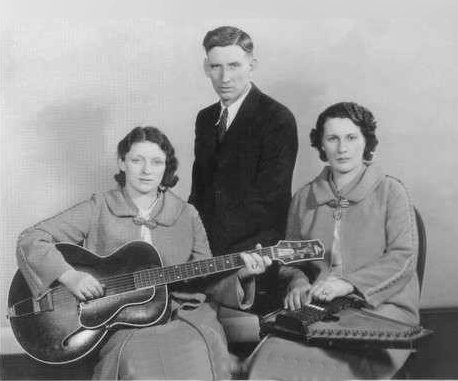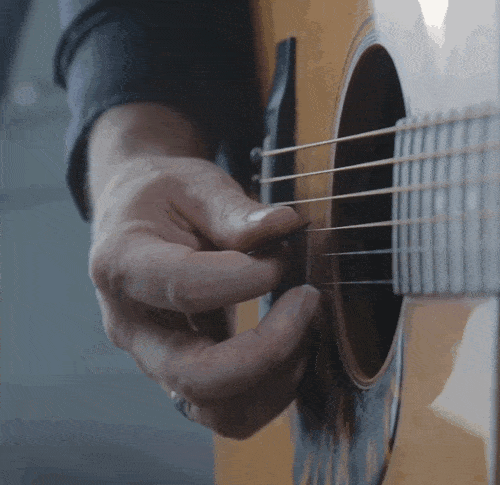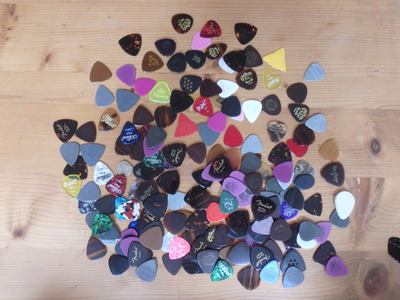Bluegrass music can get pretty flashy, and while you don't need to aim for those levels of virtuosity, this can make getting into lead playing (an already scary task in and of itself) all the more intimidating. And as often, the most difficult thing can be knowing where to begin.
Well, here's a few suggestions on how to get started. We won't dive too much into anything specific and rather point out some techniques and general concepts that may not be too obvious and should provide a good introduction to the style while remaining useful as you get further.
Whether you're still afraid of the very idea of playing melodies or you're already accomplished in other genres (possibly coming from the electric guitar), I hope those tips will get you on the right track.
Back to basics

You might have discovered Bluegrass via current players like Molly Tuttle or Billy Strings. Or maybe you fell in love with Tony Rice. That's great, and there's a lot to learn from them all. But I would advise starting with earlier stuff. Much, much earlier.
Not only because it will give you a better understanding of the genre and how it evolved over time (although it will defnitely do that), but mostly because the earlier you go, the simpler things get.
Art is built on what came before. And as each generation expands on the tradition, the fundational set of techniques and vocabulary that define the form gets that much thicker. Just like learning how to walk before you run, you'll have a much easier time figuring out what the modern greats are doing if you understand what influenced them. Trust me, Billy Strings' playing seems a lot less crazy when you're already familiar with Doc Watson.1
You don't have to spend all your time on the older stuff if that's not quite your jam. But if you struggle with something, figuring out where that thing comes from and working on the earlier and likely simpler version can only help.
This article goes into much more depth on this idea of chronological learning and is full of great references. If you do like the old-fashioned, pre-actual-bluegrass sound, then simply listening to the names listed there can keep you occupied for quite a while =)
Carter Style

As far as country lead guitar in general is concerned, you can't really go much further back than Maybelle Carter. Sometimes called the "carter scratch", the style she developped is often cited as the first use of guitar as a lead instrument.2
She played with a thumb pick, but the technique is easy to emulate with a straight one. The basic idea is to play a stripped down version of the melody on the bass strings and to interject a light chord strum or two at every pause to keep the rhythm going.
Notice how little her left hand moves ? That's because most of the melody notes are part of the underlying chord, which mean you don't have to reach for them. Fretting the passing notes while keeping the chord ringing can feel tricky in the begining. Just take it slow and don't worry if it sounds mechanical at first. Focus on hitting the right strings and give your hands some time to get in sync.
Once you get the basics down, go ahead and explore what you have. Pick a few simple vocal tunes and try and figure out their melody. Again, most of it will fall on frets you're already holding, so this gives you a nice point of reference to guide your ears. Try to stick to the keys of C or G, as those positions lend themselves ideally to this technique.
Once you get into playing more single note lines, having spent some time with this style will help a lot, as you'll be used to visualising the chord shapes and how they relate to the scale or melody you're playing. This will make identifying your chord tones and learning how to outline the harmony much easier.
And one last bonus: if you decide to get into crosspicking3 later on, the overall concept is pretty much the same, so you'll be able to simply focus on refining the right hand without having to think about the left one.
Don't think of it as just a stepping stone to the fancier stuff, though. Having this tool on your belt should remain pretty useful, especially when you're playing by yourself or in a small ensemble. Even in its most basic form, some songs won't need anything more. And if you do want to dress it up, adding just a few slurs and some syncopation can go a pretty long way. Norman Blake is a master at this.
For a more detailed breakdown of the technique, here's a pretty good two parts video series dedicated to it.
Brush up on those major scales
Like just about any american genre, you'll find some blues in Bluegrass.4 And harmonically, the defining aspect of the blues is an ambivalence between major and minor tonalities. This is why beginers are often advised to start with the minor pentatonic scale, as it will sound just fine over actual minor tunes, and clash in a really nice way in situations where it's not the theoretically "proper" scale to use.
While this works great in the rock world, historically country music tends to be a lot more subtle about this, so I would recommend starting with the major pentatonic. Most melodies will fall within that scale, and learning to follow the changes should be much easier.
Learning how to use this scale will probably take a little while. There are plenty of ressources across the web on this topic, though, so I'll let you explore on your own.
Get dirty
Sticking to major doesn't mean you should entirely avoid the blue notes5, though. As I said above, the blues is part of Bluegrass. Once you get those major scales under your fingers, single out the third note from one of them and lower it by a half-step (ie, down one fret). Play it over some backing track.
Sounds pretty nasty by itself, right ? Well, now go back to your regular third and listen as the tension resolves.
This is the blues. Whether or not you understand the theory behind it, this is the one harmonic concept you'll have to get in your ears if you ever want to sound like you know what you're doing.
There are millions of ways to handle that minor to major move. The simplest one is to just throw that dirty third anywhere you feel and simply resolve it immediately, or to use it as a passing tone. Throw in a hammer-on for effect. In fact, if you know your basic G run, you're already doing it:
e ------------------
B ------------------
G ---------------0--
D ----------0-2-----
A ---0-1^2----------
E -3----------------
^ Here it is!
Another cool trick is to find spots where the two thirds lie on adjacent strings and rock back and forth between them. In C, this can get you this classic Doc lick:
v Nice!
e ---0---0--------------------
G -4---4---1-----1------------
B -----------2-0---2-0--------
D ---------------------1^0----
A -------------------------3--
E ----------------------------
^ Another dirty third, this time resolving to the second.
Add a seventh to the mix, and things can get pretty nasty =)
You may want to apply some restraint depending on the mood you're going for (some songs really don't like that level of tension), but when it's appropriate, feel free to go crazy. You'll hear that motif over and over in many classic recordings. Train your ears to spot it, it's pretty distinctive so it shouldn't take too long and will help your transcribing quite a bit.
That's not how Tony did it

For a long time, Country musicians remained pretty shy about those dissonances, and you'll find them only sparingly in the earlier recordings. But starting around the 60's, guitarists started to embrace basing their solos around the minor pentatonic, like a bluesman would.
Tony Rice is the one who brought this approach to Bluegrass, and it sounds great. If you want to get mean and crank up the attitude, that's the way to go.
It won't work on every tune, though, and that may just be me, but I find it trickier to get right, especially if you don't want to sound too much like a Tony wannabe.6
Now if you like that sound, by all means go for it. But I do think that learning to think in major and jazz it up as needed will leave you wth a better understanding of it all. It's easier to start from the harmonically "correct" approach and spot where and how you can stray from the rules, than figuring out how to straighten things up after having broken them.
The mighty Rest Stroke
Back to technique. That one, while fairly common, doesn't seem to be mentionned as often as I think it should.
It's deceptively simple: as you push your pick through one string, make sure it lands and comes to "rest" against the one below it.

Watch the original video for a fuller demonstration.
It's trickier than it looks and tends to mess with your timing, so pay extra attention to that. Also, be careful not to apply too much force, as it can easily overwhelm your guitar's top and get it to buzz.
Most people use it only sparingly, and I would advise doing the same, at least until you get really confident with it. But whenever you need a note to really pop, the rest stroke is the way to go.
The one obvious place for it is at the end of a G run. Try it with and without resting and tell me which one sounds right.
It's also a great way to emphasise your bass runs. Or your regular bass notes, if you find yourself playing without a bass player and need to fill in that role.
Playing a slow blues and wanting to get a real rootsy and aggressive tone ? Ditch the alternate picking and use rest strokes on every note.
This technique was developed to get the volume needed to be heard in purely accoustic setting, and is an essential component of Gipsy Jazz right hand technique.7 I assume it faded out of fashion as amplification solved the volume issue, but I would still consider it an essential skill for any accoustic genre, plugged in or not.
(Some old guys still played that way on electric, and it's a pretty cool tone too.)
Again, it's not that easy to execute cleanly, and it can be fairly hard to incorporate into whatever else you're doing (I'm still struggling with the bass player impersonation exemple I gave above). Also, it's definitely not appropriate in all situations. You'll need to develop a feel for when and when not to use it.
The nice thing is that you don't have to try and master it right away. As far as the right hand goes, there's already plenty to keep it busy with regular alternate picking.8 Just be aware that it's available and work out how to fit it in when needed. Even if you only ever use it on G runs, that will stll make a difference.
Thicken up

If you're used to thinner picks, then I'd strongly advise moving up a gauge or two. You don't have to go for the thickest thing you can get, but I would avoid anything under 1 millimetter. I personally don't care too much about the actual thickness anymore, but focus on having as little flex as possible (and ideally, none at all).
This will give you much better control and precision, which will become more and more crucial as the tempo speeds up. Using something meatier will also make it much easier to pull some tone out of your instrument.
It's probably gonna sound harsh at first. The fix is to loosen up your wrist and lighten your grip. I know this is (a lot) easier said than done, but being forced to work on eliminating tension can only benefit you in the long run, even if you decide to go back to something thinner.
Of course, this is not a hard rule that you have to follow. Use whatever suits you best. But do give heavier gauges a fair try before deciding, and don't rule them out simply because they feel harder to use.
Get Rhythm
This should probably be at the top of the list, but do not neglect rhythm. You can play the coolest line ever and execute it perfectly, it's gonna fall flat if your timing is even slightly off. So dust off that metronome and make sure everything's tight.
Pay attention to which notes get accented, and by how much. Keep that pulse going. Listeners should be able to still feel the groove even if you're playing by yourself. Fiddle players tend to be prety good at this, because the whole style evolved from dance music, and it wasn't uncommon for old time fiddlers to be the only musician at the ball. Give them a listen and try to emulate that feel.
Keep working on playing backup, too. Don't treat it as what you do between the fun parts9. Even if you stick to the simple boom-chuck, pay attention to your tone and dynamics, be mindful of how much space you're taking, and always ask yourself how you can best serve the song and support whoever is in the lead.
Keep it simple
Bluegrass is a simple genre. Technically challenging, sure, but harmonically there's usually not a whole lot going on. It can be tempting to try and enrich those plain chord progressions, and sometimes it can make for a nice ear twister. But it has to be done tastefully, so as often, better to err on the side of caution.
Likewise, don't feel like you have to aim for a deluge of sixteenth notes. Stick to the melody. Repeat yourself. Focus on sounding good, and try to apply the things you already know in a clever way instead of constantly reaching for new licks. You don't even have to improvise. Write out your solos in advance. This will give you time to fool around and think about what you want to do. If the end result sounds halfway decent, nobody is gonna care that it didn't came up on the spot.
Don't be afraid of sounding cliché. Clichés are the backbone of any genre. Embrace them, study them, try to understand why they became clichés in the first place. Learn the language first, and only then figure out what you want to say with it.
Allright, that's all I have for now. I hope that wasn't too confusing. My goal here was to suggest an easier and gentler way to get started and to try and demistify the process, but that's hard to do without knowing what a potential reader may or may not already know.
I guess my final advice is to take it easy. Don't rush, play around and let things develop as you go. Don't get too bogged down in what you should or should not do. Make mistakes, have fun, keep picking and enjoy the ride!
-
This is not a dis at Billy. I love how he proudly wears that influence on his sleeve and soaks it with attitude. And it illustrates my point perfectly: He may break conventions, but there's no way you could accuse him of not knowing his classics. ↩
-
Which is, as always when the word "first" is involved, probably bullshit. But the point is that it had a huge impact and is a great place to start. ↩
-
in which you arpegiate the chords instead of strumming them. I wouldn't go there if your right hand isn't already pretty solid. ↩
-
And no, the name "Bluegrass" has nothing to do with that fact. Also, French people: there's no "s" in there. Please stop calling it BlueZgrass. It's embarassing. ↩
-
Note the plural. I could write a whole rant about how there's not one single blue note, and why the one that's usually gets that name isn't even the most interesting one. ↩
-
Nothing wrong with stealing from Tony. He's a stapple of the genre, after all. But such a distinctive style can get tiresome when you hear it imitated too often. ↩
-
Whether or not you enjoy Gipsy Jazz, you can't argue that those guys don't know how to get crazy volume out of an accoustic guitar. ↩
-
If you're still struggling with it, then forget about rest strokes and focus on that. Straight ups and downs is what you want 99% of the time. Don't get fancy until you have the basics down cold. ↩
-
Once I got into the right mindset, I found out that I actually tended to enjoy playing rhythm more and more. I almost regret taking up singing, as I wish I could spend more time focusing on just backup. ↩